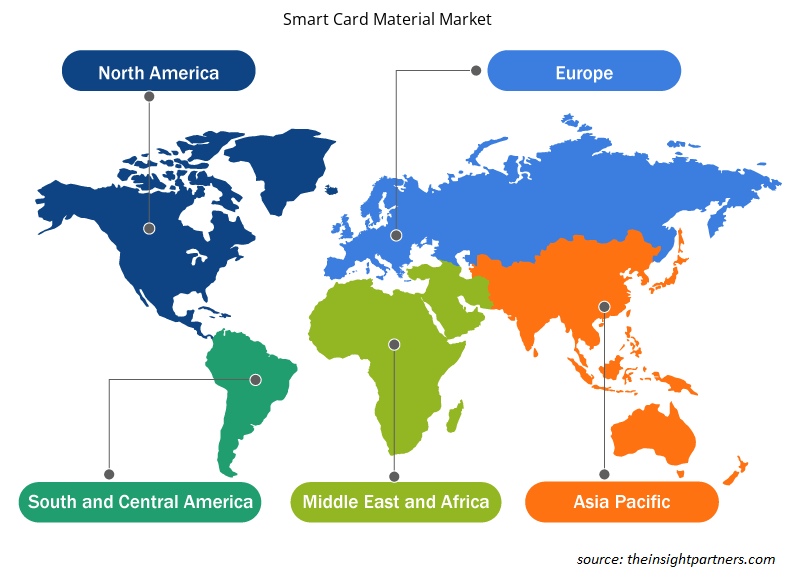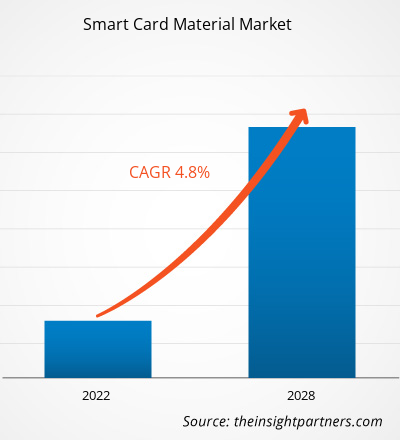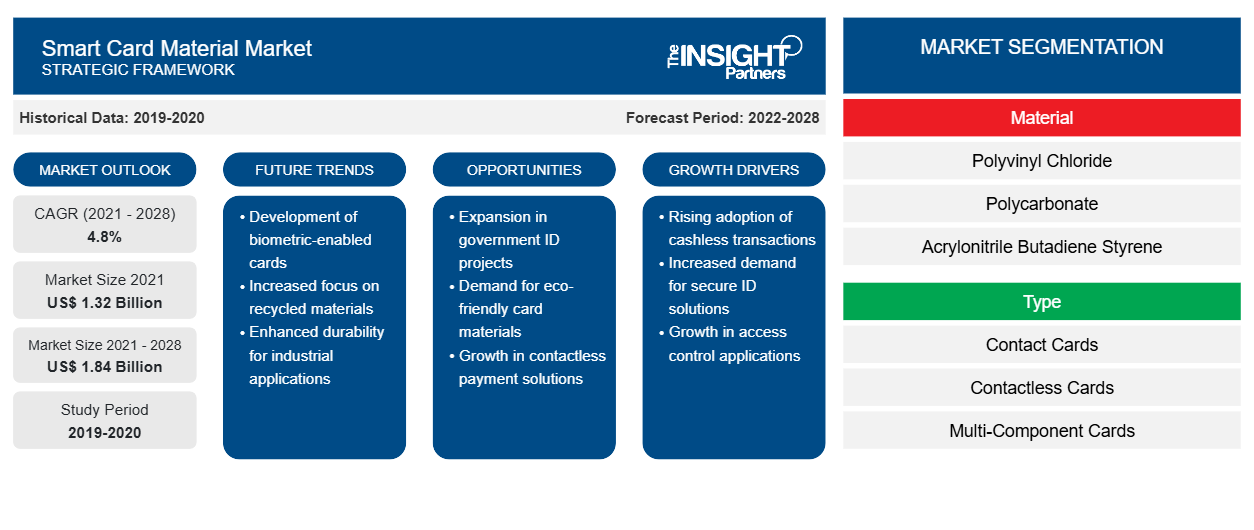스마트카드 소재 시장 규모는 2021년 13억 2,457만 달러에서 2028년 18억 3,778만 달러로 성장할 것으로 전망되며, 2021년에서 2028년까지 연평균 성장률 4.8%로 성장할 것으로 예상됩니다.
스마트 카드는 칩 카드의 한 유형으로, 데이터를 저장하고 거래하는 메모리 또는 마이크로프로세서 유형의 내장형 컴퓨터 칩이 들어 있는 플라스틱 카드입니다. 이 데이터는 일반적으로 칩 내부에 저장되고 처리되는 가치 또는 정보 또는 둘 다와 연관됩니다. 스마트 카드 소재는 이러한 카드 제조에 사용되는 화학 소재를 말합니다. 이러한 소재는 카드 위에 정보를 내장하고 인쇄하는 것을 지원합니다.
2020년 아시아 태평양 지역은 글로벌 스마트 카드 소재 시장 에서 가장 큰 점유율을 차지했습니다 . 이 지역의 스마트 카드 소재에 대한 수요는 통신 부문에서 스마트 카드 사용이 증가함에 따라 증가하고 있습니다. 또한, 증가하는 세계화 추세와 급증하는 은행, 금융 서비스 및 보험(BFSI) 산업은 이 지역의 스마트 카드 소재 시장 성장을 촉진하는 주요 요인입니다.
귀하의 요구 사항에 맞게 이 보고서를 사용자 정의하세요
이 보고서의 일부 또는 국가 수준 분석, Excel 데이터 팩을 포함하여 모든 보고서에 대한 사용자 정의를 무료로 받을 수 있으며 신생 기업 및 대학을 위한 훌륭한 혜택과 할인 혜택을 이용할 수 있습니다.
-
이 보고서의 주요 시장 동향을 알아보세요.이 무료 샘플에는 시장 동향부터 추정 및 예측까지 다양한 데이터 분석이 포함됩니다.
COVID-19 팬데믹이 스마트 카드 소재 시장에 미치는 영향
진행 중인 COVID-19 팬데믹은 화학 및 소재 부문의 지위를 크게 바꾸었고 스마트 카드 소재 시장의 성장에 영향을 미쳤습니다. 여러 산업 부문의 실적이 크게 하락하면서 스마트 카드 소재에 대한 수요가 영향을 받았습니다. 팬데믹의 영향은 다양한 애플리케이션 세그먼트에 따라 다릅니다. 데이터 트래픽과 음성 서비스의 급증은 광대역 및 모바일 데이터 센터 운영자를 포함한 많은 통신 사업자에게 혜택을 주었습니다. 그러나 정부가 부과한 봉쇄 조치는 스마트 카드 제조에 필요한 PVS, ABS, PETG와 같은 원자재의 공급망을 교란했습니다. 질병 확산은 정부 및 BFSI 부문의 운영에 부정적인 영향을 미쳤습니다. 그러나 경제가 운영을 되살릴 계획이기 때문에 앞으로 몇 년 동안 스마트 카드 소재에 대한 수요가 전 세계적으로 증가할 것으로 예상됩니다.
시장 통찰력
통신 및 의료 부문의 상당한 성장
스마트 카드는 통신 부문에서 광범위하게 사용됩니다. 이 부문에서 스마트 카드의 가장 두드러진 용도는 가입자 식별 모듈(SIM) 카드 또는 범용 집적 회로 카드(UICC) 형태입니다. 이러한 스마트 카드는 대부분 폴리염화비닐(PVC)과 아크릴로니트릴 부타디엔 스티렌(ABS) 소재로 제조됩니다. 이 부문의 애플리케이션에 사용되는 스마트 카드 기술은 지난 수년 동안 지속적으로 발전하여 이러한 카드의 소비가 증가했습니다. 또한 전 세계의 의료 기관은 광범위한 기능과 애플리케이션을 갖춘 스마트 건강 카드를 구현하고 있습니다.
스마트 카드 소재 시장 지역 통찰력
Insight Partners의 분석가들은 예측 기간 동안 스마트 카드 소재 시장에 영향을 미치는 지역적 추세와 요인을 철저히 설명했습니다. 이 섹션에서는 북미, 유럽, 아시아 태평양, 중동 및 아프리카, 남미 및 중미의 스마트 카드 소재 시장 세그먼트와 지리적 분포도 논의합니다.

- 스마트 카드 소재 시장에 대한 지역별 특정 데이터 얻기
스마트 카드 소재 시장 보고서 범위
| 보고서 속성 | 세부 |
|---|---|
| 2021년 시장 규모 | 13억 2천만 달러 |
| 2028년까지 시장 규모 | 18억 4천만 달러 |
| 글로벌 CAGR (2021-2028) | 4.8% |
| 역사적 데이터 | 2019-2020 |
| 예측 기간 | 2022-2028 |
| 다루는 세그먼트 |
재료별로
|
| 포함된 지역 및 국가 |
북아메리카
|
| 시장 선도 기업 및 주요 회사 프로필 |
|
스마트 카드 소재 시장 참여자 밀도: 비즈니스 역학에 미치는 영향 이해
스마트 카드 소재 시장은 소비자 선호도의 변화, 기술 발전, 제품의 이점에 대한 인식 증가와 같은 요인으로 인해 최종 사용자 수요가 증가함에 따라 빠르게 성장하고 있습니다. 수요가 증가함에 따라 기업은 제품을 확장하고, 소비자의 요구를 충족하기 위해 혁신하고, 새로운 트렌드를 활용하여 시장 성장을 더욱 촉진하고 있습니다.
시장 참여자 밀도는 특정 시장이나 산업 내에서 운영되는 회사나 기업의 분포를 말합니다. 주어진 시장 공간에 얼마나 많은 경쟁자(시장 참여자)가 존재하는지 그 규모나 총 시장 가치에 비해 나타냅니다.
스마트 카드 소재 시장에서 활동하는 주요 회사는 다음과 같습니다.
- 이스트먼 케미컬 컴퍼니
- 페트로차이나 주식회사
- 솔베이 SA
- 캠 원
- 사빅
면책 조항 : 위에 나열된 회사는 어떤 특별한 순서에 따라 순위가 매겨지지 않았습니다.

- 스마트 카드 소재 시장 주요 업체 개요 알아보기
애플리케이션 인사이트
스마트 카드 소재 시장은 응용 분야별로 BFSI, 정부, 통신, 소매, 의료, 호텔 및 기타로 세분화됩니다. 통신 부문은 2020년 스마트 카드 소재 시장에서 가장 큰 점유율을 차지했습니다. 스마트 카드는 선불(저장 가치 메모리 카드) 전화 카드 및 모바일 폰의 마이크로프로세서 스마트 카드 기반 SIM 카드 또는 UICC로 사용됩니다. 이 부문에서 가장 많이 판매되는 스마트 카드 제품은 양과 가치 측면에서 SIM과 UICC입니다.
글로벌 스마트 카드 소재 시장에서 활동하는 몇몇 기업으로는 Eastman Chemical Company, PetroChina Company Limited, Solvay SA, KEM ONE, SABIC, 3A Composites GmbH, Teijin Limited, LG Chem, BASF SE, Westlake Chemical Corporation 등이 있습니다.
스포트라이트 보고서
- 스마트 카드 소재 시장의 진보적인 산업 동향은 플레이어가 효과적인 장기 전략을 개발하는 데 도움이 됩니다.
- 선진국과 개발도상국 시장에서 운영되는 기업이 채택한 사업 성장 전략
- 2019년부터 2028년까지 스마트카드 소재시장의 정량적 분석
- 스마트카드 소재에 대한 글로벌 수요 추산
- 산업에서 운영되는 구매자와 공급자의 효율성을 설명하기 위한 포터의 5가지 힘 분석
- 경쟁 시장 시나리오를 이해하기 위한 최근 개발
- 스마트카드 소재 시장 성장을 주도하고 억제하는 요인과 더불어 시장 동향 및 전망
- 상업적 관심을 뒷받침하는 시장 전략을 강조하여 의사 결정 프로세스 지원, 스마트 카드 소재 시장 성장으로 이어짐
- 다양한 노드에서의 스마트카드 소재 시장 규모
- 시장의 세부적인 개요 및 세분화, 스마트 카드 소재 산업 역학
- 성장 가능성이 유망한 다양한 지역의 스마트카드 소재 시장 규모
스마트 카드 소재 시장
재료별로
- 폴리염화비닐(PVC)
- 폴리카보네이트(PC)
- 아크릴로니트릴 부타디엔 스티렌(ABS)
- 폴리에틸렌 테레프탈레이트 글리콜(PETG)
- 기타
유형별로
- 연락처 카드
- 비접촉식 카드
- 다중 구성 요소 카드
응용 프로그램으로
- 증권거래위원회
- 정부
- 통신
- 소매
- 헬스케어
- 환대
- 기타
회사 프로필
- 이스트먼 케미컬 컴퍼니
- 페트로차이나 주식회사
- 솔베이 SA
- 캠 원
- 사빅
- 3A 복합소재 GmbH
- 테이진 리미티드
- 엘지화학
- 바스프 SE
- 웨스트레이크 케미컬 코퍼레이션
- 과거 분석(2년), 기준 연도, CAGR을 포함한 예측(7년)
- PEST 및 SWOT 분석
- 시장 규모 가치/거래량 - 글로벌, 지역, 국가
- 산업 및 경쟁 환경
- Excel 데이터세트
최근 보고서
사용 후기
구매 이유
- 정보에 기반한 의사 결정
- 시장 역학 이해
- 경쟁 분석
- 고객 인사이트
- 시장 예측
- 위험 완화
- 전략 기획
- 투자 타당성 분석
- 신흥 시장 파악
- 마케팅 전략 강화
- 운영 효율성 향상
- 규제 동향에 발맞춰 대응























 무료 샘플 받기 - 스마트 카드 소재 시장
무료 샘플 받기 - 스마트 카드 소재 시장